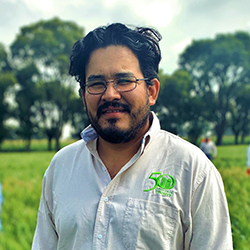Breeding Technologies, Part 1
08:20 EDT / 12:20 UTC
Moderator: Suchismita Mondal, CIMMYT
- Retrospective analysis of CIMMYT’s strategies to achieve genetic gain and perspectives on integrating genomic selection for grain yield in bread wheat
- Definition of target population of environments in India and their prediction with CIMMYT’s international nurseries
- Exploiting diversity in the bread wheat D-genome progenitor
- Breeding Technologies Part 1 Discussion
Retrospective analysis of CIMMYT’s strategies to achieve genetic gain and perspectives on integrating genomic selection for grain yield in bread wheat

Speaker:
Philomin Juliana, CIMMYT
Abstract
The annual rate of genetic gain for grain yield (GY) in wheat is about 1%. To accelerate this rate, the Global Wheat Program (GWP) at CIMMYT uses a number of successful breeding strategies and constantly evaluates potential new technologies. However, several questions remain concerning the appropriateness of strategies used by the GWP. Hence, the objective of this study was to perform a retrospective analysis of some breeding strategies using genomic and quantitative genetic approaches, in addition to exploring the value of integrating genomic selection (GS) in the yield testing stages. First, to understand if phenotypic selection for GY has had any impact on increasing the proportion of favorable alleles (FA) in the globally distributed Elite Spring Wheat Yield Trials (ESWYT) cohorts across years, we used markers consistently associated with grain yield in different environments and observed that the average number of GY FA at these markers has increased by 50.3% from the 32nd ESWYT (2012-2013) to the 37th ESWYT (2016-2017), indicating that phenotypic selection has been successful in shifting the FA frequencies upward. Secondly, to determine if GY phenotype based parent selection was effective, we did a genomic profiling of the lines in the crossing blocks using GY linked markers and observed that in the most elite crossing block of 2019, 96.8% of the 31 parents had GY FA greater than 60% and in the second most elite crossing block, 98.7% of the 153 parents had a FA frequency greater than 60% at the selected markers. These results substantiated the effectiveness of phenotype based parent selection, while illustrating the potential for integrating genomic information in parent selection. Thirdly, to examine the effectiveness of indirect selection for GY in the selection environments of Obregon, Mexico relative to that of direct selection in the target environments, we calculated the heritabilities, genetic correlations and ratios of response to indirect vs direct selection for GY in the 36th and the 37th ESWYTs, across 44 locations globally. Our results indicated that 66% of the 44 sites had mean ratios of response to indirect vs direct selection greater than one and 82% of the sites had ratios greater than 0.5, primarily due to the low heritabilities in the target sites (84.1% of the sites had heritabilities less than 0.50) and the relative high heritabilities in Obregon, thereby demonstrating the efficiency of indirect selection for GY in Obregon. Fourthly, to understand if there is a shared genetic basis of GY in the selection and target environments, we performed genome-wide association mapping using GY data from Obregon and several international sites and observed that loci on chromosomes 2A, 3B, 4D and 6A were observed in both the selection and target environments indicating the existence of a common set of loci controlling GY in these environments. Fifthly, to test the feasibility of GS and sparse testing for GY, we modeled more than 60,000 GY observations from Obregon and the global sites using genomic and genotype x environment (GxE) interaction models and compared the accuracies with baseline accuracies, to understand the relative advantage of using genomics for predicting GY. Considering different scenarios like prediction of GY (i) for a subset of lines within a year (ii) for the same lines evaluated in a different year and site (iii) for the same lines evaluated in a correlated site, we observed highly variable accuracies across the years and cohorts studied. In addition, we observed similar genomic prediction accuracies as the baseline pedigree-based accuracies mainly because of the small family sizes in the yield testing stages and also similar accuracies from the model incorporating GxE interactions and the model with line and environment effects only, due to the large environment variance compared to the genetic and GxE variance and further studies on the fit of GS in the framework of applied wheat breeding programs are needed. In conclusion, GY is a challenging trait for GS because of its environmental sensitivity and multi-environment trials are still indispensable for minimizing risk and achieving continued increase in genetic gain for GY.
Definition of target population of environments in India and their prediction with CIMMYT’s international nurseries

Speaker:
Leonardo Crespo-Herrera, CIMMYT
Abstract
CIMMYT distributes improved wheat germplasm as international trials and nurseries to targeted countries of Asia, Africa, Latin America and beyond to National collaborators. The environments where these trials and nurseries are grown have large variability in time and space. Hence, the final products of the breeding program are also diverse and specially selected for its resilience. The main objective the breeding program is to deliver superior wheat germplasm to national programs, thus it can be released as varieties for farmers in a defined set of target population of environments (TPEs). Breeders at CIMMYT, however, make selections in a selected sample of environments (SEs). The SEs are identified for predicting the performance in the TPEs but the SEs do not belong to the TPE. CIMMYT’s SEs are located in northwest Mexico (CIMMYT-Obregon), and consist of five environments differing in their water management, fertilization rates and planting time. The TPEs can be characterized by climatic, soil and hydrological characteristics as well as by socioeconomics characteristics and seed production systems. If the lines in SE should predict those in the TPE then (1) it is important to compute the genetic correlations between the lines in SE versus the same (or related lines) in the TPE and show some relatively high correlations between lines in SE and in TPE; (2) for screening lines in the SE the repeatability (broad sense heritability) in the SE should be high; (3) SE should allow a large number of lines to be screened at al low cost such that SE should allow to have high selection intensity.
The sites we considered to define TPEs were those in India where ESWYT germplasm was requested and data returned from crop cycles 2003-2004 to 2017-2018. We used 15 years of meteorological data from the NASA Langley Research CenterPOWER. Once the TPEs were defined by applying principal component analysis and hierarchical clustering, they were plotted in a map of India and interpolated by fitting a Thin Plate Spline (TPS) regression. The additive genetic correlations AGCs between the SEs in CIMMYT-Obregon and TPEs were estimated from the trial data after fitting a mixed model with the additive relationship matrix (A = 2COP) and the factor-analytic structure. CIMMYT-Obregon SEs were: 1) Beds 5 irrigations (B5IR): Trials conducted on raised beds with full irrigation management (optimal), 500 mm of available water; 2) Flat 5 irrigations (F5IR): Trials planted on flat land with full irrigation (optimal), 500 mm of available water; 3) Beds 2 irrigations (B2IR). Trials conducted on raised beds with partial irrigation, 260 mm of available water; 4) Flat Drip (FDRIP): Trials planted on flat land with severe drought, 180 mm of available water; and 5) Beds late heat (BLHT): Trials planted on February, subject to heat stress and fully irrigated, 500 mm of available water.
We obtained three main TPEs that explained most of the variation in the data set. These TPEs tended to concentrate in three main geographical zones in India. TPE 1, representing the Northwestern Zone, TPE 2 in the Northeastern Zone, and TPE3 in the Central-Peninsular Zone. All SEs displayed positive AGC with the three TPEs in India. The TPE 1, considered as high yielding environment in India, displayed more optimal conditions for wheat growing, given the lower minimum temperature, and higher water availability throughout the crop cycle than in TPE 2 and 3. The TPEs identified in our analysis account by 97% of the wheat producing areas in India. TPE 1 correlated with the irrigated, partially irrigated and drought environments. TPE 2 and 3 correlated with drought related environments in CIMMYT-Obregon. We predicted 95% of the lines on the sites at each TPE using the CIMMYT-Obregon data from the SEs to train the model. The average prediction accuracy across years between each SE and TPE ranged from 0.34-0.64. Our results confirm the high relevance of CIMMYT-Obregon as a testing site for CIMMYT’s global bread wheat breeding strategy, by allowing the selection of superior germplasm under distinct management conditions that correlate with large agroecological zones for wheat production in India. Furthermore, the selection under these CIMMYT-Obregon environments, allows the identification of elite germplasm carrying yield stability, which is paramount for farmer in the current global scenario, where they have to face the uncertainties of the climate and the year-to-year variation.
Exploiting diversity in the bread wheat D-genome progenitor

Speaker:
Kumar Gaurav, John Innes Centre
Abstract
The wild relatives of wheat form a vast reservoir of genetic diversity some of which can be introduced into cultivated wheat to improve resilience to biotic and abiotic stresses, increase yield and enhance other agronomically important traits. This diversity can be explored through association genetics on a sequence-configured panel. To capture the full extent of the diversity, we need to go beyond calling SNPs and small indels using a single reference but also take into account structural variants and presence/absence polymorphisms using multiple reference genomes. The traditional association mapping approach of read alignment to every reference assembly followed by variant (SNP/small indels) calling and association check, is inherently limited, both in terms of variant types as well as computational efficiency. We have developed a computationally-efficient k-mer—based association mapping approach, which can detect a much wider range of variants and requires the association algorithm to be run only once independently of the number of reference assemblies. We demonstrate the power of this approach to identify novel gene candidates for non-NLR mediated disease resistance, stress tolerance and yield, using the whole genome shotgun data of the Aegilops tauschii panel available under the aegis of the Open Wild Wheat Consortium (http://www.openwildwheat.org/).
Breeding Technologies, Part 1 Discussion led by Moderator Suchismita Mondal, CIMMYT

Philomin Juliana

Leonard Crespo-Herrera

Kumar Gaurav
Breeding Technologies Part 2
09:05 EDT / 13:05 UTC
Moderator: Sarah McNeil, Syngenta
- Genetic gain for grain yield and key traits in CIMMYT spring wheat germplasm- progress, challenges and prospects
- High-Throughput Phenotyping for Indirect Selection on Wheat Grain Yield at the Early-generation Seed-limited Stage in Breeding Programs
- Plant Breeding in the 21st Century: Molecular Breeding and High Throughput Phenotyping
- Vulnerability Mapping Capability – a pilot “radar” system to determine risks of host/pathogen interaction for wheat rust
- Breeding Technologies Part 2 Discussion
Genetic gain for grain yield and key traits in CIMMYT spring wheat germplasm- progress, challenges and prospects

Speaker:
Ravi Singh, CIMMYT
Abstract
The International Wheat Improvement Network (IWIN) continues to be an important source of new wheat varieties in various countries of Asia, Africa and Latin America. Over 100 direct CIMMYT-derived spring wheat varieties were released in over 20 countries during the last 5 years in all continents. This has been possible due to a strong global partnership, field-based breeding, global phenotyping coupled with the continuous evaluation and integration of new tools and technologies. Challenges posed by the races belonging to the Ug99 lineage in Africa, CIMMYT implemented Mexico-Kenya shuttle breeding and phenotyping under the Durable Rust Resistance in Wheat (DRRW) and Delivering Genetic Gains in Wheat (DGGW) projects in 2008. A strong emphasis on parental selection, targeting and optimizing of crosses, population sizes and upscaling phenotyping for grain yield and other traits resulted in the development of elite lines and varieties showing about 1% annual genetic gain for grain yield while building climate resilience, end-use quality, diverse race-specific and race-nonspecific resistance to the three rust pathogens and other relevant diseases. A major challenge faced has been the continually evolving and migrating nature of stem rust and yellow rust fungi in eastern Africa, emphasizing the need to utilize resistance complexity by selecting 4 to 5 additive race-nonspecific minor resistance genes, 2-3 minor genes with partially effective race-specific genes, or multiple race-specific genes to enhance resistance durability in cultivars.
A large-scale effort initiated in 2013 to implement genomic selection (GS) and high-throughput phenotyping (HTP) in CIMMYT wheat breeding. The program permitted genotyping and HTP of all entries in stage 1 and stage 2 yield trials in Mexico and expanded the phenotyping of a large set of elite lines at multiple field sites across South Asia. The extensive genotypic and phenotypic data were used in building and optimizing prediction models, meta-GWAS for grain yield, agronomic and quality traits and disease resistance, and used in advancement decisions. We also learnt the limitations of GS in wheat. Only about a third of the top yielding lines could be predicted by GEBV (Genomic Estimated Breeding Value) and therefore had limitations in selecting best parents for recycling. GS combined with meta-GWAS derived IBD-regions (Identical-by-Descent) and actual phenotypic data however might predict superior cross combinations.
To further accelerate the rate of genetic gain we are: 1) developing and piloting low-cost breeding scheme(s) that would further shorten the generation advancement time by 1 or 2 years from the currently used scheme while maintaining the genetic gain from strong field based selection; and 2) improving the parental selection for recycling using a combination of genotypic and limited field performance data. In addition, trait-pipeline is also established for rapid integration of marker selectable race-specific resistance genes, important QTL and IBD regions in elite lines and new varieties using the speed-breeding facility. These are considered important steps towards accelerating genetic gain for grain yield and other traits.
High-Throughput Phenotyping for Indirect Selection on Wheat Grain Yield at the Early-generation Seed-limited Stage in Breeding Programs

Speaker:
Margaret Krause, CIMMYT, Kansas State University
Abstract
Yield testing at the early-generation stages of the wheat breeding cycle is generally not performed due to 1) the low per-plant seed yield and 2) the large number of individuals present in the breeding program. Therefore, breeders typically rely on visual selection among small, unreplicated seed increase plots for the promotion of individuals to replicated yield trials. With the development of aerial high-throughput phenotyping technologies, breeders now have the ability to rapidly phenotype tens of thousands of individuals for traits that may be useful for improving grain yield through indirect selection. We leveraged the irrigated bread wheat (Triticum aestivum L.) breeding program at the International Maize and Wheat Improvement Center to assess the extent to which aerial measurements of vegetation indices collected on small, unreplicated plots are predictive of grain yield in replicated yield trials. A population of 2,016 individuals was sown both as replicated yield trials and as small, unreplicated plots during two breeding cycles in Ciudad Obregón,. Vegetation indices collected in the small plots using an unmanned aerial vehicle were observed to be heritable and more predictive of grain yield than genomic selection models. A related experiment showed that selection approaches based on vegetation indices could be more effective than visual selection; however, selection on the vegetation indices would have also resulted in a directional response in phenology due to confounding between those traits. A restricted selection index was proposed for improving grain yield without affecting the distribution of phenology in the breeding program. These results provide a promising outlook for the use of aerial high-throughput phenotyping traits to improve selection at the early-generation seed-limited stages of wheat breeding programs, though empirical studies are needed to assess realized gains.
Plant Breeding in the 21st Century: Molecular Breeding and High Throughput Phenotyping

Speaker:
Mark Sorrells, Cornell University
Abstract
The discipline of plant breeding is experiencing a renaissance impacting crop improvement as a result of new technologies, however fundamental questions remain for predicting the phenotype and how the environment and genetics shape it. Inexpensive DNA sequencing, genotyping, new statistical methods, high throughput phenotyping and gene-editing are revolutionizing breeding methods and strategies for improving both quantitative and qualitative traits. Genomic selection (GS) models use genome-wide markers to predict performance for both phenotyped and non-phenotyped individuals. Aerial and ground imaging systems generate data on correlated traits such as canopy temperature and normalized difference vegetative index that can be combined with genotypes in multivariate models to further increase prediction accuracy and reduce the cost of advanced trials with limited replication in time and space. Design of a GS training population is crucial to the accuracy of prediction models and can be affected by many factors including population structure and composition. Prediction models can incorporate performance over multiple environments and assess GxE effects to identify a highly predictive subset of environments. We have developed a methodology for analyzing unbalanced datasets using genome-wide marker effects to group environments and identify outlier environments. Environmental covariates can be identified using a crop model and used in a GS model to predict GxE in unobserved environments and to predict performance in climate change scenarios. These new tools and knowledge challenge the plant breeder to ask the right questions and choose the tools that are appropriate for their crop and target traits. Contemporary plant breeding requires teams of people with expertise in genetics, phenotyping and statistics to improve efficiency and increase prediction accuracy in terms of genotypes, experimental design and environment sampling.
Vulnerability Mapping Capability – a pilot “radar” system to determine risks of host/pathogen interaction for wheat rust
Speaker:
Stefan Einarson, Cornell University
Abstract
.
Breeding Technologies Part 2 Discussion
Led by moderator Sarah McNeil, Syngenta

Ravi Singh

Margaret Krause

Mark Sorrells

Stefan Einarson
Physiology and Abiotic Stresses
09:55 EDT / 13:55 UTC
Moderator: Anna Backhaus, John Innes Centre
- Estimating organ contribution to grain-filling and potential for source up-regulation in wheat cultivars with contrasting source-sink balance
- Effect of nitrogen nutrition on uptake and translocation of Zn from soil and foliar Zn fertilizers by wheat and maize
- Physiology and Abiotic Stresses Discussion
Estimating organ contribution to grain-filling and potential for source up-regulation in wheat cultivars with contrasting source-sink balance

Speaker:
Carolina Rivera, CIMMYT
Abstract
It is expected that for every 1 °C increase in global temperature wheat yields will be reduced by 6%. Higher than optimal temperatures can affect growth and development through morphoanatomical, physiological and biochemical changes. Spike dry matter (DM) accumulation at anthesis and fruiting efficiency (FE= number of grains per unit of spike DM at anthesis), are key physiological components of grain number. On the other hand, high biomass has been a desirable trait for heat tolerance in wheat, but this approach must be combined with physiological strategies to maintain floret survival and grain set. The High Biomass Association Panel II (HiBAP II) comprised of 150 bread wheat spring types was evaluated for the effect of heat stress on yield, its components, FE, biomass partitioning and water-soluble carbohydrate (WSC) at anthesis for 2 years in NW Mexico. Heat stress was simulated by late sowing. The reduction in performance from yield potential to heat stress conditions, defined as ‘heat susceptibility index’ (HIS) was estimated for each trait. The aim of the study was to investigate the response of FE, biomass partitioning, and grain set to heat stress, and to explore phenotypic variation in HIS for these traits. Overall biomass production was highly associated to yield under heat stress; grain yield reductions due to heat stress where driven by lower grain number per unit area (GN). There was an average 40% reduction in FE across the 150 lines, and these where highly related to reductions in GPS, GN and grain yield. Phenotypic differences in HIS for grain set related traits were observed, lines with lower HIS for GN and FE were also the lines with a lower effect on grain yield due to heat stress. Physiological mechanisms explaining these findings, as well as heat tolerance across different genetic background of HiBAP lines will be discussed in this study.
Effect of nitrogen nutrition on uptake and translocation of Zn from soil and foliar Zn fertilizers by wheat and maize

Speaker:
Raheela Rehman, Sabanci University
Abstract
Zinc deficiency is highly prevalent worldwide, affecting one third of the world population, especially children and women in developing countries. Application of Zn fertilizer to the soil and/or to the plant as a foliar spray is considered as an instant and cost effective agronomic biofortification tool, particularly in the areas where soils are severely deficient in chemically available Zn. Application of nitrogen fertilizer is known not only to increase grain yield but also to facilitate the uptake and transport of Zn in the plant systems. Knowledge about the aspects improving root and leaf absorption of Zn from soil and foliar Zn fertilizers in wheat and maize is vital to enhance the nutritional value of these important cereal. In current study two experiments were performed to investigate the effect of nitrogen (N) supply on uptake and accumulation of Zn in maize and wheat during vegetative stage. In first experiment, maize and wheat plants grown with sufficient soil Zn, were supplied with low or adequate N in soil. Plants were harvested at two developmental stages for elemental analysis. In second experiment, maize and wheat plants were grown in marginal soil Zn at three different N rates viz: low, medium and adequate. At 3-4 leaf stage plants were sprayed with ZnSO4.7H2O. After ten days of foliar Zn spray, fresh young un-sprayed leaves were analyzed for Zn and N concentration. In first experiment, improving N supply significantly enhanced the biomass production as well as absorption and shoot accumulation of Zn in maize and wheat plants. In second experiment, under deficient soil Zn conditions, leaf uptake of Zn from foliar Zn sprays in maize and wheat was improved with increasing N level in the growth medium. These results suggest that improving nitrogen nutrition in maize and wheat is very beneficial not only to increase the plant biomass but also to boost Zn concentration in maize and wheat plants by improving absorption from soil and foliar-applied Zn. Therefore, ensuring adequate nitrogen supply to improve the nutritional quality of the cereal crops like maize and wheat can be helpful strategy to alleviate the widespread malnutrition problem.
Physiology and Abiotic Stresses Discussion
Led by Moderator Anna Backhaus, John Innes Centre

Carolina Rivera







